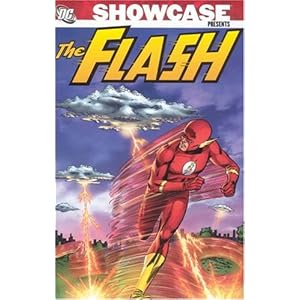What I try to do with reviews at this Bookshelf blog is keep it simple and spoiler-free, and let you know whether I'd recommend you pick up a copy of what I just read. Seems to work okay. This time, a brief review of
The Invisibles: Apocalipstick (Volume Two) (Vertigo, 1995)

Oh, my. Is this ever more like it. Rereading the first collected edition of Grant Morrison's nineties series
The Invisibles had been an exercise in frustration, with the writer assuring us that wonderful things were in store for us, but that we had to wait patiently while he set up a very complicated board game with way too many pieces first. I still think that he just plain did that badly, but after the spectacular mess that was "Arcadia," things improve greatly - exponentially - with the stories in this volume.
Having said that, DC's collected editions department, which seems to routinely manage twenty-nine belching mistakes for every moment of greatness, didn't win themselves any awards for the way that they collected The Invisibles. The first episode reprinted here ties up the loose ends and resolves the cliffhanger ending to the first book, and really should have been included there. Illustrated by Jill Thompson, it finally lets us watch the members of the team in their mystical, ass-kicking glory and it's a pleasure to read. Had it been included in Volume One, it would have ended things on a high note and left readers demanding more, rather than scratching their heads wondering what all that French Revolution time travel nonsense was.
Next, we've got the first moments of pure genius in the series, with three stand-alone episodes. These are illustrated by Chris Weston, Steve Parkhouse and John Ridgway, and flesh out the universe that we're seeing.
In any other book. Weston's and Ridgway's episodes would be duking it out for supremacy, but Parkhouse's is the runaway winner. It's called "Best Man Fall" and it's one of the best single issue comics
ever printed. Period. Telling you why would ruin it. It's a tough guy lout's story, and it's completely captivating watching him try and hold a difficult life together, and if you're like me when I first read it - I was living in UGA's Family Housing at the time and for some reason, I felt like getting off the bus home and enjoying the sun and read this episode under a tree in the Myers quad - then it will be right at the point towards the end where it's revealed
why you're following this character that you'll even start to wonder what his connection to the overall narrative is. It's so damn amazing that I clearly remember where I was when I read a funnybook almost fifteen years ago.
That, I think, would be the only real downside to starting The Invisibles with this book over the first. The payoff-PUNCH-payoff-PUNCH-payoff-PUNCH ending to "Best Man Fall" loses one punch if you haven't read the first book. So there's your tradeoff: if you start with the second book, you'll be more patient and understanding of why you might have to struggle through the first, but if you start with the first, then you get one extra punch from "Best Man Fall."
So anyway, Thompson returns to art duties as Morrison returns the story to the lead characters, focusing on the magical transvestite Lord Fanny and the international ass-kicker King Mob (Gideon) as the protagonists all try to track down their errant new member. Dane, the not-likeable-at-all audience identification figure, is mostly absent from this book, having told these terrorists to leave him alone at the end of the first.
This three-part chunk is really entertaining, and Thompson's art is much better suited to it than her previous work on the series. Despite the powerhouse story, the first episode reprinted here is a notable art stumble, with a bullets-n-fast cars pace that leaves her looking out of place. Thompson's much better able to capture Lord Fanny's present in a drag club and past in rural Mexico, and she pulls this off right at the point that Morrison's theories of time travel start to make sense.
In The Invisibles, and here's where it gets tricky, past and future are much closer to any point in the present than just about any other fictional construction (or world). Just as Lord Fanny is flashing back (for the reader's benefit?) and, shockingly and just for one panel, forward (for her's?), there's a grand page with King Mob consulting his eighty-something friend, Edith, about finding Dane and she makes a curious comment about she and Gideon having been intimate once when she was 26, long before he could have been born. I've said before, and I'll keep saying, that Morrison uses both flashbacks and foreshadowing better than anybody else in comics. Under him, they're two sides of the same coin, and he knows exactly where to place it, every time. When Morrison reached the payoffs - there are two, unforgettable - of this comment, I was literally in tears. It's that damn good.
The other thing Morrison does better than anybody else is cliffhangers. Part two of this story ends with Lord Fanny on her knees in one hell of a mess, and I think, when it was originally published, that the next thirty days were just about the longest in my life.
The book ends with Lord Fanny's and King Mob's stories unresolved, and Paul Johnson on art chores for a curiously low-key episode. This one finds Dane learning more about his powers and purpose just as the series' principal baddie, an ass of a toff called Sir Miles, catches up with him. At this stage, from the snatches we've seen in other episodes, Sir Miles is a real cardboard villain, and one of the series' few misfires. A scene in Ridgway's episode that sees him and his fellows unconcerned about a servant's death doesn't come across as monstrous or sinister, but unbelievable and comic. There's better in store for this character, but at this point, Dane becomes more interesting and sympathetic at the expense of Sir Miles. Also notable here, Johnson uses a really neat art trick to show off the manifestation of Dane's powers as we learn why the Invisibles want him to be called Jack Frost.
Overall... maybe I was wrong last time and readers really should suffer and struggle through book one first, but I think that it's almost what-side-of-the-bed-is-this close as to how I feel now that I've read both. I absolutely think that anyone who likes comics should read The Invisibles. Toss a coin and pick up either the first or the second book. Watching it unfold in either direction is an absolute joy. With, you know, occasional rough bits.















